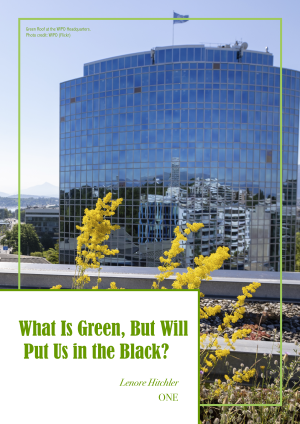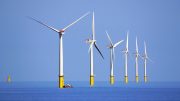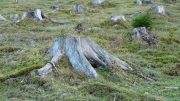 What is green but can put us in the black? The answer to this riddle is green roofs and adopting them will put us in the black both economically and environmentally. The National Resource Defense Council defines green roofs as “vegetated roof surfaces—essentially rooftops covered partially or entirely with living plants.” Green roofs are also known as living roofs, rooftop gardens, vegetated roofs, ecoroofs, and sky gardens.
What is green but can put us in the black? The answer to this riddle is green roofs and adopting them will put us in the black both economically and environmentally. The National Resource Defense Council defines green roofs as “vegetated roof surfaces—essentially rooftops covered partially or entirely with living plants.” Green roofs are also known as living roofs, rooftop gardens, vegetated roofs, ecoroofs, and sky gardens.
In the future, green roofs could cover a significant portion of urban areas and contribute to making them greener and more park-like. It is not easy to find land to create new urban parks. However, roofs are already an integral part of every city’s landscape. The amount of urban areas that are covered with roofs varies from source to source. According to an article in Frontiers in Built Environment, roofs take up the space of 20% to 25% of all urban surface areas. A somewhat different estimate is that “Green roofs can represent up to 32% of the horizontal surface of built-up areas,” according to an article in Bioscience. The New York City Department of City Planning reported that approximately 60% of the city’s total land is occupied by buildings. This amounts to 90,000 acres, equaling more than 100 times the area of Central Park. In other words, roofs represent a lot of space that could house rooftop gardens.
A cursory glimpse into the history of green roofs shows that they are not just a passing fad. The history of green roofs begins with sod roofs. Professor Chi Yung Jim, PhD, stated that sod houses have been built since at least the Neolithic period, which was defined as being the years from 8000 to 4000 BC. Remnants of sod homes have been found throughout the planet, including Alaska, parts of Canada, Greenland, Iceland, Great Britain, Norway, Siberia, and the steppes of Central Asia. Sod houses were also built in the American Great Plains during the homesteading era in the nineteenth and early twentieth centuries.
Evidence of European rooftop gardens has been found in various locations. The remains of Pompeii and Herculaneum roof gardens date back to 79 AD. Roof gardens were built during the medieval period. The Kremlin in Moscow included a roof garden during the 17th century. In 1764, Catherine the Great of Russia had a rooftop garden constructed at the Hermitage in St. Petersburg.
In New York City, a variety of rooftop gardens were built. One of the first roof gardens was erected in 1882 on the top of the Casino Theatre. In 1890, Madison Square Garden included a rooftop garden. It took up an entire block and was large enough to accommodate 4,000 people. The Paradise Roof Garden was situated atop a theater in 1899, featuring a pond, windmill, waterfall, two cows, and a milkmaid. The Hotel Astor rooftop garden was built in 1905, featuring a 20,000-square-foot roof garden with a 1,000-foot tree-lined promenade, a restaurant, and a waterfall. Another roof garden restaurant enjoyed by the affluent was established on top of the Ritz-Carlton Hotel in 1918. The first New York City rooftop library reading room, which benefited the less affluent, was built in 1919.
There are various difficulties concerning green roofs. To begin with, all government regulations regarding green roofs must be followed. For example, historic districts may not permit the installation of green roofs.
It is much easier to build a green roof on a new building than to add a green roof to an older building. New buildings can be specially designed to facilitate green rooftops, and older buildings must be overhauled. However, since urban areas are already filled with older buildings, they could be retrofitted to include living roofs.
Unfortunately, there are complications to retrofitting an older building. The building must be structurally able to support the added weight of water or snow-saturated soil and plants, the various layers that protect the building, gardening paraphernalia, and visitors. From bottom to top, the layers must include a waterproofing membrane, root barrier, drainage material, filter layer, growing medium, and the vegetation itself. The growing medium, otherwise known as a substrate, is employed instead of standard soil. It consists of both organic matter and inorganic materials, such as crushed bricks and concrete. Vegetation is the collective term for all plant life that covers a particular area, including trees, grass, flowers, and other plants.
Another disadvantage of green roofs is the environmental effects of obtaining, producing, and transporting the various materials necessary to produce green roofs. For example, according to the Massachusetts Metropolitan Planning Council Fact Sheet on Green Roofs, “Waterproof membranes are made of various materials, such as modified asphalts (bitumens), synthetic rubber (EPDM), hypolan (CPSE), and reinforced PVC.” Unfortunately, these materials contain toxic substances.
In addition, environmental factors such as drought, elevated temperatures, wind, and sunlight intensity cause stress to vegetation on green roofs. Therefore, plants on green roofs must be selected that are able to withstand these harsh conditions.
Besides choosing the right type of vegetation for the roof, the type of green roof must be chosen. There are two major types of green roofs, and each has its own advantages and disadvantages. Extensive roofs can be placed on sloping roofs and weigh less because they use a thinner growing medium. They are cheaper to build, last longer than regular roofs, and are very low maintenance. The recommended thickness of the growing medium varies among various sources. Estimates of the thickness of the growing medium usually start at around 2 inches (5.08 centimeters). According to the Environmental Protection Agency (EPA), they can be as thick as 6 inches (15.24 centimeters). The disadvantages are that they are not built to accommodate visitors and are limited to the plant species that do not need a thick growing medium. Unfortunately, plants that can thrive on extensive roofs frequently lack visual appeal.
Intensive roofs are heavier than extensive green roofs and therefore need more structural support. The EPA reported that intensive roofs have a growing medium of 6 inches or more. They are also more expensive to build and maintain than intensive roofs. They usually require irrigation and also require more maintenance. However, intensive roofs can host a greater variety of plants, can accommodate visitors, and are more attractive than extensive roofs.
Fortunately, there are many advantages to adopting green roofs. One is that they save money over a long period of time, as green roofs last longer than standard roofs. For example, a study from the University of Michigan found that a conservative estimate for the lifespan of a green roof is forty years. The same study reported that a standard roof lasts around fifteen years. The university also compared a 2,000 square meter conventional roof and a green roof. They found that “Over its estimated lifespan of 40 years, a green roof would save about $200,000, of which nearly two-thirds would come from reduced energy costs.”
Because of the insulation they provide, all types of green roofs save money during the winter by cutting energy costs. According to the Massachusetts Metropolitan Planning Council Fact Sheet on Green Roofs, “During the winter, a green roof can reduce heat loss by 25% or more.” An article in Renewable and Sustainable Energy Reviews reported that intensive green roofs, compared to black roofs, can yield a 48% energy savings in the heating season.
Besides insulating against winter’s cold, green roofs lower cooling needs in the summer. According to the EPA, a conventional roof can reach temperatures of 150 to 185 degrees Fahrenheit (66 to 85 degrees Centigrade). Vegetation on green roofs helps cool the roof in various ways. Plants on green roofs absorb water and then release it through their leaves, while water also evaporates directly from the soil and plant surfaces. In addition, plants shade the roof, and their insulating effects in addition to their growing medium lead to cooler roofs. The EPA reported that green roofs can reduce the cooling load by 70%. According to an article in Renewable and Sustainable Energy Reviews, compared to black roofs, intensive green roofs can yield an 84% energy savings in the cooling season.” In addition, when green roofs lower the amount of energy used for heating and cooling, less fossil fuels are burned, leading to a reduction in greenhouse gases, which in turn slows down climate change.
Besides cooling individual buildings, green roofs also mitigate the effects of urban heat islands. According to the National Park Service, “The temperature in cities is often higher than surrounding rural areas, a phenomenon known as the urban heat island effect. Large amounts of paved surfaces in cities absorb solar radiation and re-radiate it as heat, which increases the local air temperature. For example, during the summer months in New York City, the daily minimum temperature is on average 7.2 degrees Fahrenheit warmer than the surrounding suburban and rural areas, and even more during heat waves. Green roofs help reduce the urban heat island effect by covering conventional dark roofing surfaces with vegetation, which absorbs less heat.” In addition to vegetation reducing roof temperatures, 16 centimeters [around 6”] of substrate can reduce temperatures by 7 degrees Centigrade.
In addition to the ability of green roofs to lower the effects of hot weather, they can also mitigate the effects of strong storms. Mitigation involves taking action to reduce the negative impact of a situation. Stormwater is impeded from seeping into the ground by impervious surfaces. These surfaces include sidewalks, streets, parking lots, and rooftops. Excess stormwater can lead to floods, which in turn can cause damage to property and put human health at risk due to the spread of pathogens in floodwaters. Also, stormwater runoff picks up pollutants, which leads to water pollution.
By capturing stormwater, green roofs prevent the sewage system from overflowing. The Natural Resource Defense Council reported that a study of stormwater mitigation in New York City found “of all the practices considered, green roofs represented the most cost-effective means of retaining stormwater runoff and preventing combined sewer overflows in the city.”
The Center for Green Roof Research found that green roofs retained up to 80% of rainfall during rainstorms, compared to 24% for standard roofs. The EPA reported that “Studies have shown that extensive roofs will typically capture between 30 and nearly 100% of incoming rain.” According to Renewable and Sustainable Energy Reviews, intensive roofs have a 79% average stormwater runoff retention.
In addition to mitigating excess stormwater, green roofs mitigate pollution. The hotter the outside temperature is, the more air pollution is produced, and green roofs can mitigate this problem. According to the English Nature, which was the original name of the United Kingdom government body dealing with conservation, “Data from the US suggests that for every 3 degrees centigrade increase in temperature there is a 10% increase in polluted days.” The Massachusetts Metropolitan Planning Council Fact Sheet on Green Roofs reported that “The presence of a green roof helps to reduce air temperatures around the building, reducing the “heat island” effect and reducing the production of smog and ozone, which forms in the intense heat (175 degrees Fahrenheit) over large conventional roofs.” According to an article in Solar Energy, “when maximum daily temperatures in Los Angeles were less than 71.6 degrees Fahrenheit (22 degrees Centigrade), ozone levels were below the California standard of 90 parts per billion. At temperatures above 95 degrees Fahrenheit (35 degrees Centigrade), practically all days were smoggy.”
Besides lowering the high temperatures that increase air pollution, green roofs can lower the amount of particulates, which also contribute to air pollution. Vegetation provides vast surface areas on leaves that filter out various particulates. An article in Environmental Science & Technology reported that green roofs could remove up to 60% of particulate matter from the air. According to the EPA, “a 1,000 square foot (93 square meters) green roof can remove about 40 pounds of particulate matter from the air in a year.” An article in Atmospheric Environment reported that a study found a total of 1.846 tons (1675 kilograms) of pollutants were removed by 46.45 acres (19.8 hectares) of the Chicago green roofs included in the study.
In addition to lowering air pollution, green roofs also lower noise pollution. Excess noise can impair human health, leading to ailments such as insomnia, hearing loss, hypertension, heart disease, etc. Fortunately, the insulating layers found on green roofs, plus plants and their growing medium, can absorb sound waves more effectively than standard roofs. Also, the thicker the substrate is, the better it can absorb sound waves. According to an article in Renewable and Sustainable Energy Reviews, green roofs can decrease noise levels from 5 decibels to 20 decibels. A much higher statistic is provided by Kathleen Westbrook, who has a Master of Science degree in climate science. She stated that “Studies indicate that green roofs can reduce noise levels by up to 40 decibels.”
Thus, adopting green roofs improves the climate—both metaphorically and literally. If living roofs were encouraged as part of a national and international energy and environmental strategy, the resulting lower temperatures and energy use would result in less climate change. In addition, urban areas would become more pleasant, parklike, and healthier. Therefore, erecting a vast number of green roofs would contribute to the economic and environmental health of the planet.
Lenore Hitchler





